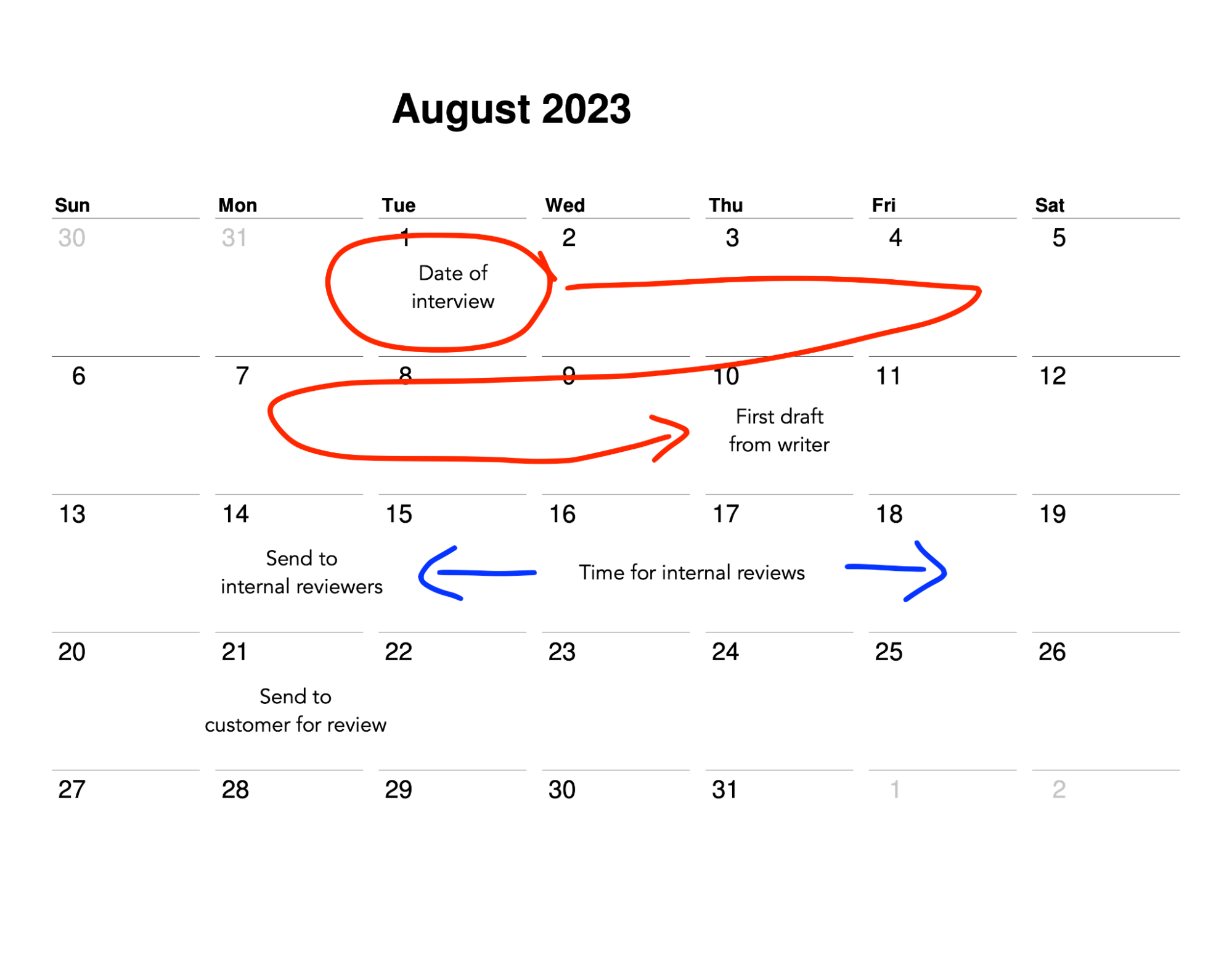Creating customer stories is hard. If it wasn’t, you probably wouldn’t have read past the headline. But, here we are.
One of the biggest complaints of marketers is how long it takes to publish customer stories. While certain aspects of the process will always be out of your hands, like in life, it’s important to control what you can.
In a recent webinar, I outlined a framework for radically reducing your story production time by focusing on:
- Generating customer excitement
- Managing customer expectations
- Fostering internal alignment
The entire webinar is worth watching (on-demand link here), but if you’re looking for a shorter version, here are some key areas of focus.
Sell the Vision
Often, customers volunteer for case studies because they’re throwing us a bone, or, worse, they’re contractually obligated. But these motivations don’t exactly spark excitement. When the individual customer you’re interviewing doesn’t buy into the personal value, they have little incentive to go to bat for you against gatekeepers or provide an expedited review.
But when done correctly, these stories can make your customer the hero. The storyline doesn’t need to suggest their incompetence and that your solution saved the day. The case study can show how they’re leaders who saw a problem and had the courage and foresight to fix it.
When your customer is the genuine hero of your story, it can elevate them and their personal brand. Let’s be honest: the people who get promotions and raises aren’t only the ones who deserve them. Those honors are bestowed upon the people who speak up and showcase their success. To turn this case study ask into a genuine opportunity, you need to sell this story to your customer as a surefire way to unveil their individual accomplishments and build their personal brand.
Unfortunately, most case studies don’t make the customer the hero. But you can check out this previous webinar to learn a better way to accomplish that. Once you’ve developed a better way to properly showcase your customers, get them excited about this opportunity.
TL;DR: Properly build excitement with your customer. This story isn’t an ask by you—it’s an opportunity to highlight their success to their boss, company, and industry at large.
Get Everyone on the Same Page
Story approval by both your internal team and the customer is, hands down, the greatest culprit for extending production time. But the biggest reason why it takes so long is that people don’t know what to expect—or when to expect it.
Think of how often your customer does an interview, only to be left in the dark. Weeks or months go by without a word. Then, one day when they’re busy, you send the first draft.
The same surprise happens with internal reviewers. It doesn’t take two weeks to review a 1,000-word story. But because they had no idea when they’d receive it, they couldn’t carve out the time.
Here’s a secret: you can actually let people know when the draft will be ready to review.
Let’s say your writing team is like Upshot, and they take 5–7 business days to write a story. That means if the interview happens on August 1st, the first draft is ready to review by August 10th.

With a turnaround time like this in mind, you can line up everything else. Factoring in a couple days for your own review, let your internal reviewers know they’ll get the draft no later than August 14th, and give them a deadline for completion. Have them add a 30-minute block of time to their schedule right now to review.
You can then manage customer expectations. Ideally, they’ve already been briefed on the value of the story, the time commitment involved, and what the overall process looks like. But you can take this a step further by letting them know they’ll get the first draft by August 21st.
Most people can’t carve out an hour of time today or tomorrow. But they can two weeks from now. Let people know when they’ll get the story, and you’ll instantly see faster approval processes.
TL;DR: Use your writing turnaround time to plan exactly when internal reviews will happen and when your customer will see the first draft. Send calendar invites for review, and adhere to those timelines.
Stick the Landing
You’ve laid the groundwork, and now it’s time to execute. Get your story to interview reviewers on (or before) that promised date. If you don’t stay on schedule at the start, everything can easily fall apart.
When sending to your internal reviewers, also ensure they understand their roles. If you absolutely have to show your legal team (please avoid if possible), they shouldn’t provide editorial feedback. Make sure the product marketing manager knows their job is to just offer feedback on the product messaging.
The more everyone tries to cover everything, the more directions the story will take, and the further away it will be from your customer’s vision and voice. Give everyone a specific job and make sure they stick to the agreed upon timeline. They’re not doing this for you—they’re doing it for the customer.
Once your team has reviewed, you’ll send the story to the customer for review. At this point, you need to top up the excitement level. Share positive internal feedback you’ve received about the story. Have their CSM or account manager reach out to say they loved the story and can’t wait to see it live. If necessary (and allowed), consider sending them a small incentive to get started. Maybe a gift card for a coffee to sip while they review, or for food delivery so they can check the story over their lunch.
TL;DR: Stick to your internal review schedule and ensure every reviewer has laser focus. And when sending the story to your customer, top up that excitement level.
In the end, a single action won’t make every story go faster. Things will happen: Your customer may leave their company. They might go on medical leave. They could completely ghost you. But by generating the proper excitement with your customer and your team, letting everyone know exactly when they’ll get their drafts, and then executing on those timelines, you’ll instantly see stories produced faster.
This formula isn’t earth-shattering, but it also isn’t a pie-in-the-sky concept that can only be applied at specific organizations. And that’s the beauty of it: These are simple tweaks you can make on your very next case study to cut down production time.
Here’s wishing you a career of prompt story approvals.










































